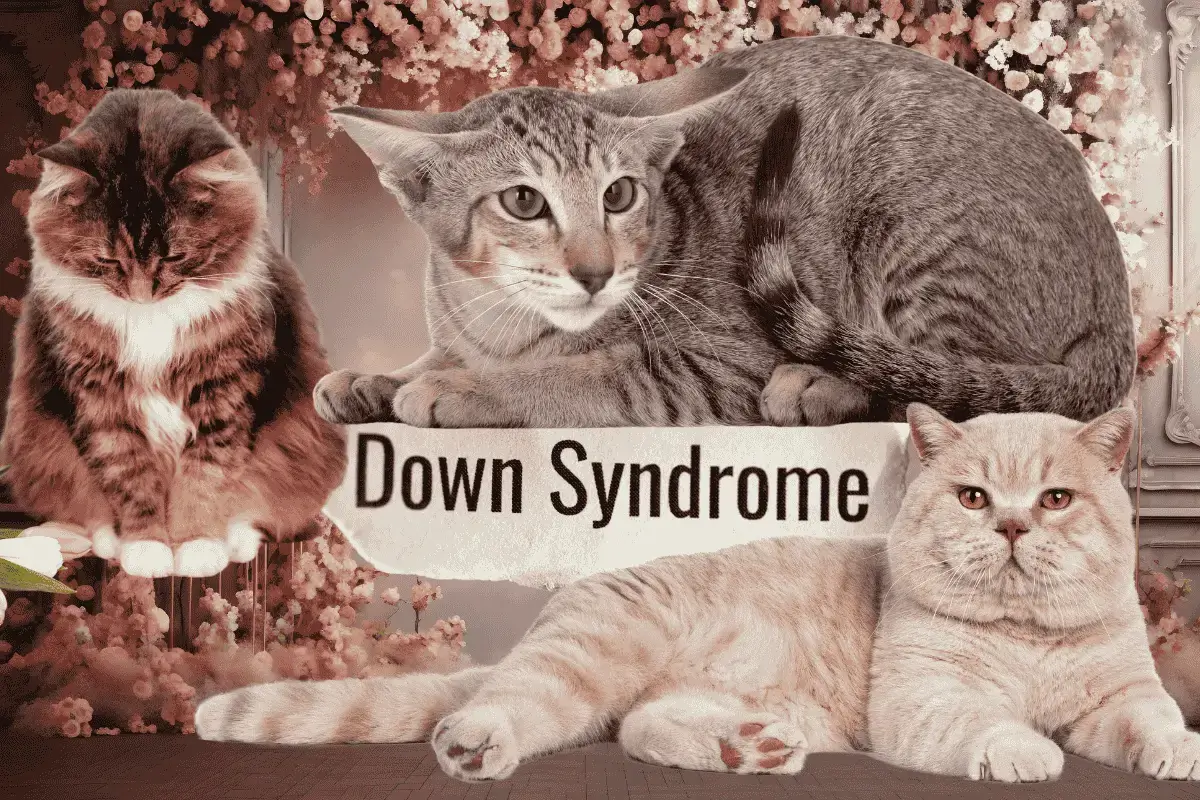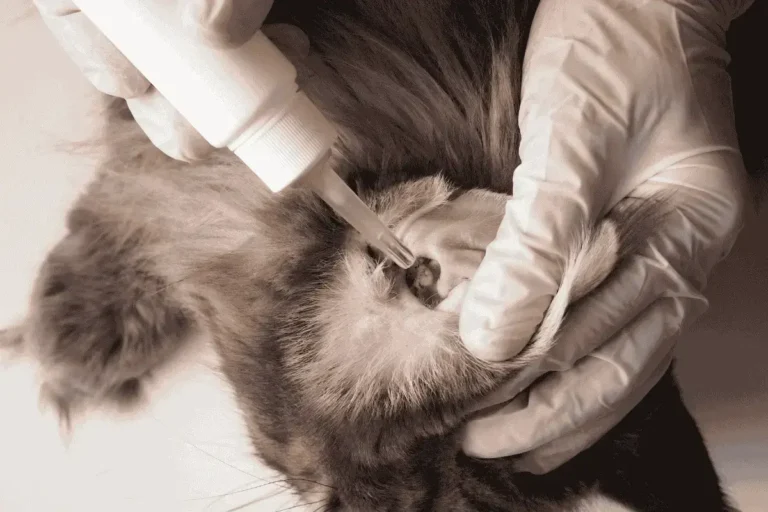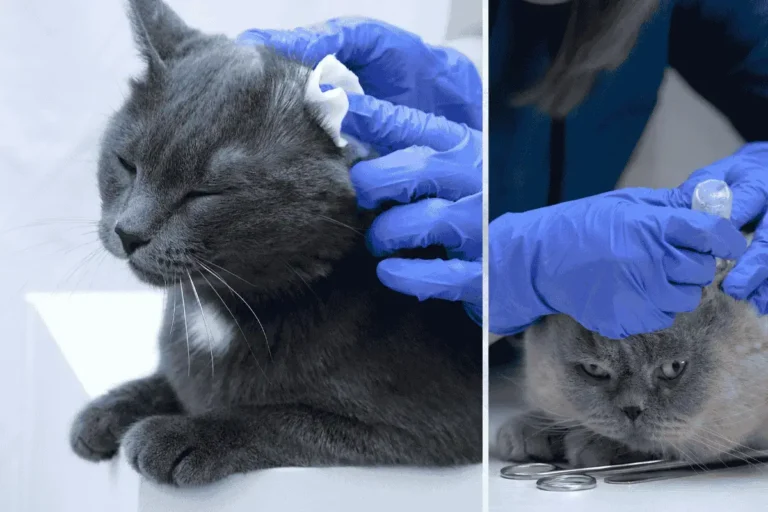How to Care for a Cat with Down Syndrome-Like Symptoms
Being a cat parent can be tricky, especially when your pet faces challenges. Cat with Down syndrome are not actually affected by it. They might look and act similar, but they need special care.
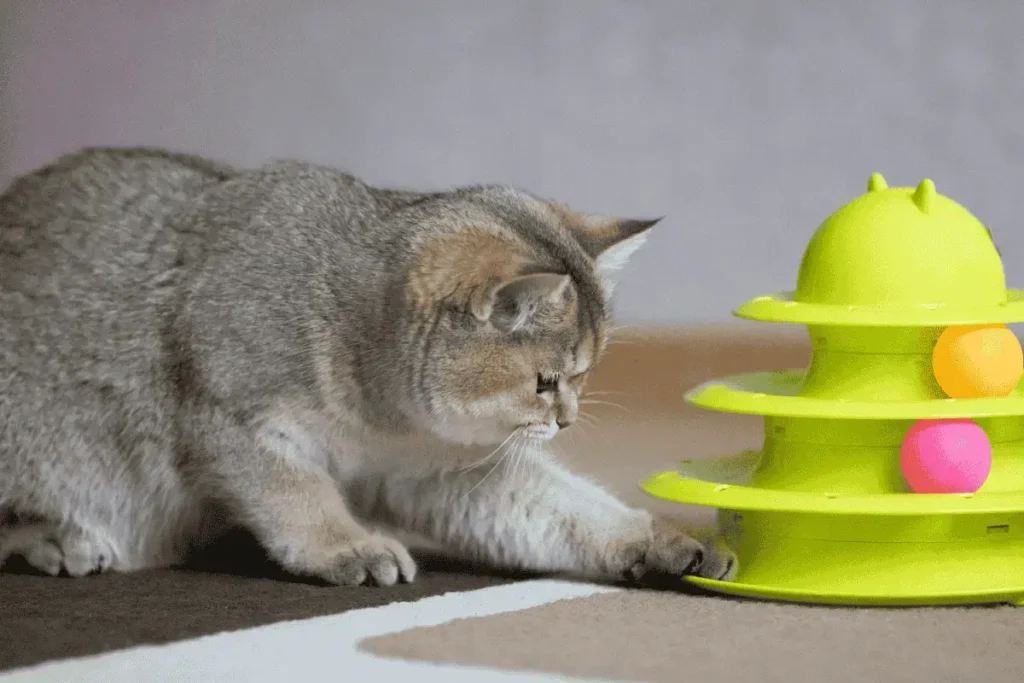
Key Takeaways
- Cats cannot develop Down syndrome due to their different chromosome structure.
- Genetic abnormalities, congenital disabilities, and environmental factors can lead to cat behaviors and physical traits that resemble Down syndrome.
- Cats with these “Down syndrome-like” symptoms require specialized care and attention to ensure their well-being.
- Regular veterinary check-ups, customized diets, and a supportive home environment are crucial for the care of these special needs cats.
- Engaging cats with cognitive or behavioral differences in play and social interaction can aid in their development and adaptation.
Understanding Feline Genetics and Down Syndrome
Cats and humans have distinct genetic structures. While humans carry 23 pairs of chromosomes, cats have only 19 pairs. Because of this difference, cats can’t actually have Down syndrome, which in humans results from an extra copy of chromosome 21.
Even though cats can’t have Down syndrome, they can still get genetic conditions that look similar. These conditions have different causes and symptoms. This can lead to misunderstandings about a cat’s needs.
Chromosomal Differences Between Humans and Cats
Cats and humans have different genetic blueprints. Humans have 23 pairs of chromosomes, and cats have 19 pairs. This difference means cats can’t have the same genetic problem as humans with Down syndrome.
Why True Down Syndrome Cannot Occur in Cats
Down syndrome in people happens due to the presence of an added copy of chromosome 21. This leads to various physical and cognitive issues. Since cats don’t have this chromosome, they can’t have Down syndrome.
Common Misconceptions About Feline Genetic Conditions
Some cat owners think their cat has Down syndrome because of similarities in appearance or behavior. But, these conditions in cats are usually caused by other genetic problems, not true Down syndrome.
Condition Cause Prevalence Symptoms
| Condition | Cause | Prevalence | Symptoms |
|---|---|---|---|
| Cri-du-chat syndrome | Deletion of part of chromosome 5 | Approximately 15% of cases have a parent with a chromosome rearrangement, and up to 10% of affected infants may not survive the first year | Long, narrow face, abnormal dentition, crossed eyes, short stature, early graying of the hair, breathing problems, infections, difficulty eating, and reflux |
| Feline Infectious Peritonitis (FIP) | Caused by a mutation in the feline coronavirus (FCoV) | 25-40% of household cats have been infected with FCoV, with the infection rate increasing to 80-100% in multi-cat households. 80% of FIP cases are in cats less than 2 years old. | Fluctuating fever, lethargy, reduced appetite, inflammation affecting various organs, and a ‘wet’ or ‘dry’ form of the disease |
Understanding the genetic differences between humans and cats helps us see their unique needs. This knowledge helps us care for our feline friends better.
Physical Characteristics That Mimic Down Syndrome
Cats can’t get true Down syndrome, but some breeds look like they might. This is because of genetic or congenital disabilities, not the same as Down syndrome in humans.
Cats that look like they have Down syndrome might have a flat nose or wide eyes. They could also have a small jaw or loose joints. Some might have vision problems or an upturned nose. These traits are not Down syndrome in cats but come from other genetic or birth issues.
These similarities are just on the surface. They don’t show the profound effects of Down syndrome on humans. Cats with these traits might need special care, but they don’t face the same issues as people with Down syndrome.
| Feline Trait | Possible Cause |
|---|---|
| Flattened or pushed-in nose | Brachycephaly, a common trait in short-nosed cat breeds |
| Wide-set eyes | Genetic or developmental abnormalities in facial structure |
| Smaller jaw | Genetic or congenital conditions affecting jaw development |
| Loose joints | Connective tissue disorders or congenital joint laxity |
| Vision problems | Ocular abnormalities or neurological issues |
| Upturned nose | Nasal and facial deformities, potentially linked to brachycephaly |
These traits might look like Down syndrome, but they’re different in cats. Knowing the unique genetic and birth factors in cats is critical. It helps us give them the proper care and support.
Common Behavioral Signs in Cats with Special Needs
Cats with special needs may show signs like down syndrome in cat or down syndrome for cats. These signs can be due to motor issues, social problems, or learning delays. But, true Down syndrome can’t happen in cats.
Motor Function Challenges
Cats with special needs might have trouble moving around. They could limp or find it hard to jump. About 50% of these cats might also groom too much, chase their tails, or act obsessively. These actions could be linked to their brain or genes.
Social Interaction Patterns
Cats with do cats have Down syndrome-like traits might find it hard to interact with others. They might stay away from other cats and prefer to be alone. Some cats with autism-like traits might like routines and find it hard to change their environment. This can make socializing tough for them.
Learning and Development Issues
Cats with special needs might have trouble learning and growing. They might learn slowly, find it hard to adjust to new things and show signs of anxiety or stress. They might groom too much, lick or bite their skin, or pace a lot. A calm, structured place and behavioral therapy can help them learn and grow.
| Behavioral Characteristic | Description |
|---|---|
| Motor Function Challenges | Unsteady gait, difficulty balancing and jumping, repetitive behaviors like excessive grooming or tail-chasing |
| Social Interaction Patterns | Avoidance of social interaction, preference for solitude, difficulty adapting to changes in routine |
| Learning and Development Issues | Delayed or impaired learning, anxiety-related behaviors like over-grooming or pacing |
Knowing and dealing with these signs in cats with special needs is critical. It helps give them the best care and support. This ensures they live well and happily.
What Causes Down Syndrome-Like Features in Cats
Cats can’t get true Down syndrome, but they might look or act like they do. This is because of genetic problems, congenital disabilities, or exposure to harmful substances. These issues can cause physical and behavioral problems in cats, similar to Down syndrome in humans.
It’s critical to remember that these issues in cats are different from Down syndrome. Knowing the cause helps owners give their cats the best care.s in cats are different from Down syndrome. Knowing the cause helps owners give their cats the best care.
Genetic Factors
Cats have 19 pairs of chromosomes, unlike humans, with 23 pairs. This means they can’t have the extra chromosome 21 that causes Down syndrome. However, genetic problems can still make cats look or act like they have Down syndrome.
Congenital Defects and Developmental Issues
Cpecific congenital disabilities, like cerebellar hypoplasia, can cause cats to have trouble moving or acting strangely. These problems can come from viruses or other factors during pregnancy. Neurological issues, like liver problems or deafness, can also make cats seem like they have Down syndrome.
Exposure to Toxins and Infections
BBeing exposed to harmful substances or viruses during development can harm a cat’s growth. For example, the feline panleukopenia virus can damage a cat’s brain and make them act strangely, similar to Down syndrome.
It’s essential to get a vet’s help to figure out and treat any issues that make a cat seem like they have Down syndrome. With the correct care, these cats can live happy lives.
Identifying Developmental Delays and Abnormalities
When caring for a cat with Down syndrome-like symptoms, it’s vital to watch its growth closely. Spotting early signs of delays or oddities helps your cat get the proper care. This ensures they can live their best life.
Physical Development Markers
Watching your cat’s physical growth can tell you a lot about their health. Look out for:
- Delayed motor skills, like trouble with balance or moving
- Unusual looks, like a flat face, small ears, or a sticking-out tongue
- Low muscle tone, making them seem very relaxed
Behavioral Development Signs
Behavioral signs also help spot cats with Down syndrome-like traits. Keep an eye on:
- Slow learning of simple tasks, like using the litter box
- Hard time reacting to sounds or sights
- Struggling to connect with other cats or people
Regular vet visits are vital for catching and treating any issues early. Working with your vet ensures your cat gets the care they need to do well.
“Caring for a cat with special needs requires patience, dedication, and a deep understanding of their unique challenges. With the right support, they can lead happy, fulfilling lives.”
Creating a Safe Home Environment for Special Needs Cats
Caring for a cat with special needs is a big responsibility. It would help if you made their home safe and comfy. These cats often need special care, and a few changes can really help.
It’s critical to have quiet spots for these cats. They might get stressed by loud noises or too much activity. So, setting up calm areas in your home is essential. Make sure they can easily find food, water, and litter boxes. You might also need ramps or steps for them to move around.
When you interact with these cats, be gentle and calm. Avoid sudden noises or movements that could scare them. Having a routine and a stable home environment helps them feel more secure.
| Modification | Purpose |
|---|---|
| Quiet retreat areas | Provide a safe space for cats to escape overwhelming stimuli |
| Easy access to resources | Ensure cats can reach food, water, and litter boxes with minimal effort |
| Ramps and steps | Assist cats with mobility challenges in navigating their environment |
| Gentle handling and calm atmosphere | Help cats with special needs feel secure and minimize stress |
By making these changes, you can make a loving home for your special needs cat. They can live a happy and full life. Remember, can cats have down syndrome or similar conditions, and with the right care, they can still enjoy a happy and enriched existence.
Essential Medical Care and Veterinary Support
Caring for a cat with Down syndrome-like symptoms needs regular vet visits and unique plans. Keeping an eye on their health is key to their happiness. Your vet will help manage their medical needs and tackle any health issues they might have.
Regular Health Monitoring
Cats with these features should see the vet often for check-ups and tests. This includes physical exams, genetic tests, and watching their vital signs. Your vet will work with you to create a care plan that fits your cat’s needs.
Specialized Treatment Plans
Your vet might suggest unique treatments based on your cat’s genetic and physical traits. This could be medicines, therapies, or other interventions for heart, lung, or brain issues. It’s essential to stay in touch with your vet to make sure your cat gets the best care.
Supporting cats with Down syndrome-like symptoms needs a caring and dedicated approach. By following your vet’s advice, you can help your special cat live a happy and comfortable life.
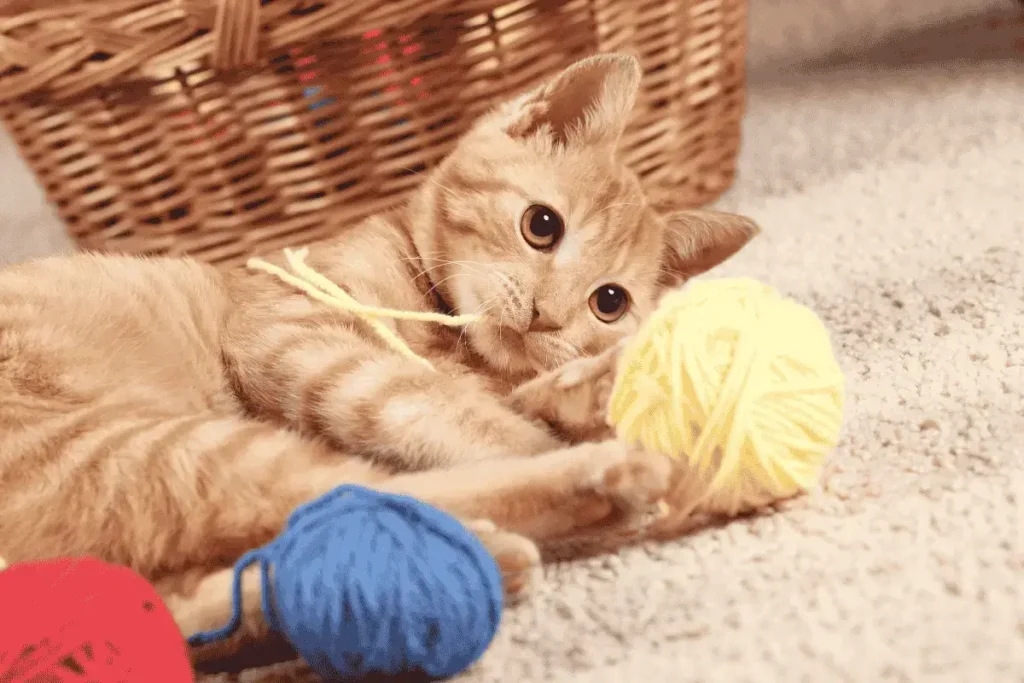
“Caring for a cat with special needs requires patience, dedication, and a willingness to adapt. With the right support and resources, these remarkable felines can thrive and enrich our lives in countless ways.”
Nutrition and Dietary Requirements
Caring for a cat with Down syndrome-like symptoms means paying close attention to its diet. These cats might need special foods to stay healthy. It’s important to talk to a vet to find the right food for your cat.
Cats need to eat meat because their bodies are made for it. Cats with special needs should eat high-quality, meat-based foods. This could be wet or dry food that has all the nutrients they need.
Your vet might also suggest adding particular nutrients or even a homemade diet. This is especially true for cats with Down syndrome-like symptoms who might have trouble digesting some foods or need extra help.
- Make sure your cat’s food is high in meat and low in carbs.
- Give them both wet and dry food to mimic hunting.
- Feed them small meals all day to match their natural eating habits.
- Please don’t give your cat with Down syndrome-like symptoms dog food, as it’s not right for them.
- Keep an eye on your cat’s weight and body shape to make sure they’re healthy.
By working with your vet and adjusting your cat’s diet, you can help meet their nutritional needs. This will support their health and happiness.
“Proper nutrition is essential for the health and development of cats, especially those with special needs. A tailored diet can make a significant difference in their quality of life.”
Daily Care Routines for Cat with Down Syndrome Like Symptoms
Caring for a cat with Down syndrome-like symptoms needs patience and gentleness. These cats might have special grooming and hygiene needs. They also might need different exercise and activity levels. By understanding and meeting their special needs, pet owners can make sure their cats with feline down syndrome or down syndrom cat symptoms live happy, full lives.
Grooming and Hygiene
Cats with can animals get down syndrome traits often struggle with grooming. Regular, gentle brushing helps remove extra hair and prevents skin problems. It’s also important to clean their ears, eyes, and nails gently to keep them clean.
Exercise and Activity Modifications
Cats with Down syndrome-like symptoms still need mental and physical stimulation. But, their exercise needs might be different. Owners should use suitable toys and playtime but watch for any physical limitations. Gentle play, short training, and low-impact activities are good for them without being too complicated.
Keeping a consistent daily care routine is critical for cats with special needs. Being patient, flexible, and willing to adapt is essential. This ensures these cats get the care and support they need.
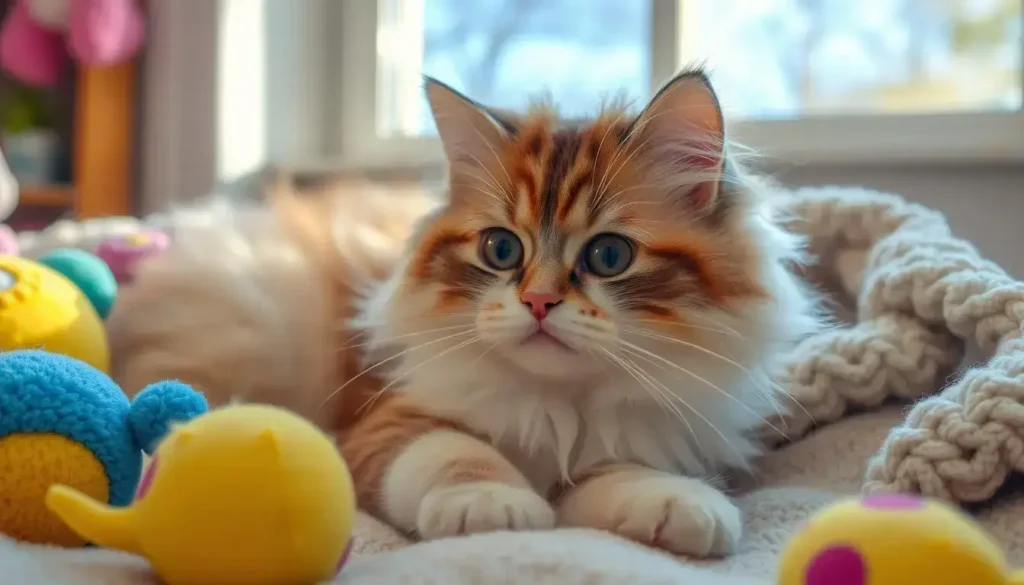
Social Integration and Environmental Enrichment
It’s vital to ensure the social well-being and enrich the environment for cats with Down syndrome-like symptoms. These cats need extra care and attention to thrive at home. Introducing suitable toys, engaging in play, and creating safe spaces can make their environment stimulating and supportive.
Introducing them to other pets slowly can also help. This should be done carefully to ensure a positive experience. Remember, some cats may not do well with other pets, so it’s essential to consider their temperament and needs first.
Adding vertical spaces, scratching posts, and hiding spots can reduce stress and anxiety. These elements fulfill their natural behaviors and provide comfort. By customizing their environment, you can help them thrive and live a fulfilling life.
FAQ
Can cats have Down syndrome?
No, cats can’t have true Down syndrome because of their different chromosomes. However, they might show traits like Down syndrome due to genetic issues, congenital disabilities, or environmental factors.
What are the physical characteristics that mimic Down syndrome in cats?
Cats that seem to have Down syndrome might have a flat nose, wide-set eyes, or a small jaw. They could also have loose joints, vision problems, or an upturned nose.
What are the typical behavioral signs in cats with special needs?
Cats with special needs might have trouble moving, balancing, and socializing. They might be shy around other cats and have learning and development issues.
What causes Down syndrome-like features in cats?
Down syndrome-like traits in cats can come from genetic problems, congenital disabilities, infections during pregnancy, or toxins. These can cause physical issues, brain problems, and delays in development.
How can you identify developmental delays and abnormalities in cats?
Spotting developmental delays in cats means looking for physical and behavioral signs. This includes slow motor skills, unusual looks, slow learning, and trouble responding to things.
What are the essential medical care and veterinary support needs for cats with Down syndrome-like symptoms?
Cats with Down syndrome-like symptoms need regular vet visits for health checks and to manage ongoing problems. They might need unique treatments like genetic tests, tailored meds, and therapies for their health issues.
What are the nutrition and dietary requirements for cats with Down syndrome-like symptoms?
Cats with special needs might need special diets. This could mean high-quality cat food, specific supplements, or unique formulas to help with their health.
How can you create a safe home environment for special needs cats?
Making a safe home for special needs cats means making changes for them. This includes quiet spots, easy access to things, and ramps or steps for moving around.
How can you incorporate social integration and environmental enrichment for special needs cats?
It’s important to help special needs cats feel connected and engaged. This means giving them fun toys, interactive play, and safe places to explore. Also, introducing them to other pets slowly and gently is key.

